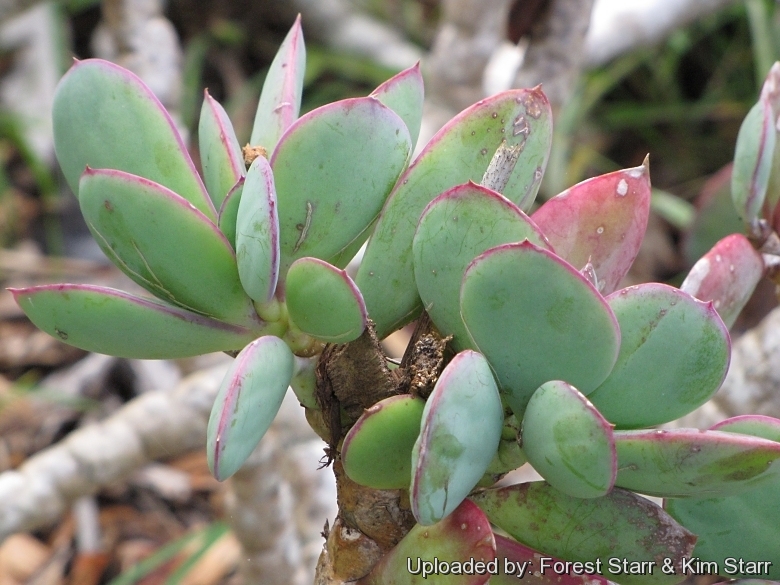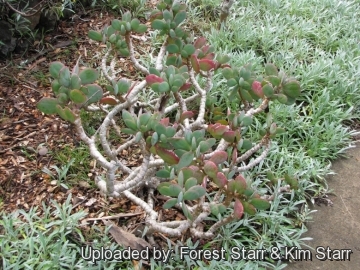




Your support is critical to our success.
Compos. Madagascar (Mem. Soc. Linn. Normand. xxv), 143, 304 1923
Family: ASTERACEAE

Leaves at Kula Botanical Garden, Maui, Hawaii (USA). March 07, 2011.
Origin and Habitat: Senecio crassissimusSN|29042]]SN|29042]] is endemic to Madagascar.
Habitat and ecology: This species thrives in rocky, sun-sweltering environment along with a staggering number of succulent species such as: Pachypodium densiflorumSN|14808]]SN|14808]], Euphorbia miliiSN|26570]]SN|23360]], Euphorbia xylophylloidesSN|23360]]SN|26570]], Aloe acutissima, etc. It has adapted to its harsh environment by changing the direction of its succulent leaf surfaces so that there is no flat surface directly facing the sun. When the sun is in its most intense position, directly overhead, the plant has just a leaf edge facing the sun. This prevents moisture from evaporating. Because the plant's leaf edges point up and down, rather than the conventional flat surface with edges from side to side, it forms a propeller appearance.
Synonyms:
- Senecio crassissimus Humbert
ENGLISH: Vertical leaf senecio, Vertical leaf, Lavender Steps, Propeller plant
CHINESE (中文): 多肉植物-紫蠻刀, 紫章
SPANISH (Español): Senecio de hoja vertical, Senecio vertical
SWEDISH (Svenska): Tvärstånds
Description: Senecio crassissimusSN|29042]]SN|29042]], colloquially known as "Vertical leaf senecio" or "Propeller plant" is an evergreen leaf-succulent subshrub 45-80 cm tall by 40 cm wide with vertical ranks of silver-grey laterally positioned purple rimmed flattened fleshy leaves. Thick erect, stems produce bright yellow daisy like flowers at the tips in mid-summer to autumn. The large leaves looking as if turned on edge are the most distinctive feature.
Stems: Erect, succulent, thick greyish-green to purple, with leaf scars below.
Leaves: Laterally compressed, mostly obovate, but variable in profile, size and colour, 5-10 cm long and 3 cm wide, 2-5 mm thick, waxy silver-grey or bluish with vivid purple margins, facing outwards, veined and tapered to short stalks below. Apex stiff mucronate. The propeller plant has an ability to trap moisture with its foliage, because sometimes this is the only means by which these plants are able to maintain it. The moisture often comes only in the forms of mist, fog or vapour. If you look carefully at the propeller plant, you will see that it has a grey look to its leaf surface; however this is not its true colour. The grey surface can be wiped away, leaving a light green colour exposed beneath. The grey is not dust, but a collection of millions of tiny scale-like surfaces designed to trap moisture.
Inflorescences: Inflorescence-stalk terminal, 30-60(-100) cm long, with scale-like bracts, branched towards the top into a loose corymb to bear 30 or more daisy-like heads .
Capitula (flowers heads): ± 6 mm in diameter. Phyllaries about 10. Ray florets 5 or rarely 6, yellow. Disc florets yellow.
Blooming season: Mid-summer to autumn or winter.
Chromosome number: 2n = 20.
Bibliography: Major references and further lectures
1) Forest & Kim Starr “Senecio crassissimus (Vertical leaf senecio)”. Plants of Hawaii. <http://www.starrenvironmental.com>. Web. 27 Sep. 2014.
2) Wikipedia contributors. "Senecio crassissimus." Wikipedia, The Free Encyclopedia. Wikipedia, The Free Encyclopedia, 5 Mar. 2009. Web. 10 Oct. 2014.
3) Werner Rauh “Succulent and xerophytic plants of Madagascar” Volume 1 Strawberry Press, 1995
4) Urs Eggli “Illustrated Handbook of Succulent Plants: Dicotyledons” Springer Science & Business Media, 2002
5) Gordon D. Rowley “Flowering succulents” Living Colour Publications, 1959
6) Gordon D. Rowley “Succulent Compositae: A Grower's Guide to the Succulent Species of Senecio und Otbonna” Strawberry Press, 1994
7) Hermann Jacobsen “A Handbook of Succulent Plants: Ficus to Zygophyllum” Blandford Press, 1960
8) Werner Rauh “The Wonderful World of Succulents: Cultivation and Description of Selected Succulent Plants Other Than Cacti” Smithsonian Institution Press, 1984
9) San Marcos Growers contributors “Senecio crassissimus- Vertical Leaf Senecio”. San Marcos Growers <http://www.smgrowers.com>. Web. 27 Sep. 2014.
10) Christoper Brickell (Editor-in-chief) "RHS A-Z Encyclopedia of Garden Plants" Third edition. Dorling Kindersley, London 2003
11) Mary Wright “Propeller plant thrives in the rockiest, sun-sweltering environment” The Edmonton Journal February 20, 2006 <http://www.househunting.ca/story.html?id=8bb0ee3e-afad-4dc5-84be-b6abf8720764>

Habit at Kula Botanical Garden, Maui, Hawaii (USA). March 07, 2011. Photo by: Forest Starr & Kim Starr
The gallery now contains thousands of pictures, however it is possible to do even more. We are, of course, seeking photos of species not yet shown in the gallery but not only that, we are also looking for better pictures than those already present. Read More...
Cultivation and Propagation: Senecio crassissimusSN|29042]]SN|29042]] is an interesting and unique plant with the unusual colour combination of purple and grey on leaves that appear to be turned on their edge. It is a most rewarding plant that grows in full sun and has no problems with extreme heat or cold down 0° Celsius. Senecio crassissimusSN|29042]]SN|29042]] may be best combined in a large container with other succulent types.
Soil: It requires a very free draining soil used for cacti and other succulents, mildly acidic to mildly alkaline but is very tolerant of poor soils.
Fertilization: Fertilizer is seldom a necessity for these plants as the soil is rocky and desolate in their natural habitat.
Watering: It needs moderate water during from spring to autumn, keep rather dry in winter or the plants may rot at the base. The plant will tolerate being dried out much more than other types of succulents. The converse is also true, the plant will suffer greatly from over watering.
Exposition: They seem to do well in full sun to part shade such as at the base of open trees, but thrives better in hot sunny positions and will tolerate coastal conditions, but prefers light shade in the summer.
Frost Tolerance: It is cultivated in open air in the tropical and warm Mediterranean climate, with temperatures which it is good to keep over the 5°C, best 10-12°C, but can withstand light frost for short periods if very dry (hardy down to -0º C, even if with damage to the foliage) in these situations it will better resist if sheltered by the winter rains, seen that the humidity and low temperatures render it more sensitive to rottenness, however, watch it carefully as frost will kill the plant. Plants in containers however, suffered major leaf loss. USDA Zone (9b-)10 to11(-12).
Wind and salt tolerance: Tolerates wind and second line salt wind.
Maintenance: The flower stems need to be removed to keep a tidy appearance. These species do tend to get sort of leggy, which is particularly a problem if grown as a potted plant, and trimming back is often necessary.
Propagation: It is easy to propagate by cuttings in late spring to summer, just take a cutting of the plant let it dry for 1 or 2 weeks and stuff it in the ground (preferably dry, loose, extremely well draining soil).
| Your Actions | |
|---|---|
| Back to Senecio index | |
| Back to Asteraceae index | |
 |
Back to Succulents Encyclopedia index |
Privacy stantement - Terms and conditions - How to cite - About us - Feedback - Donate




